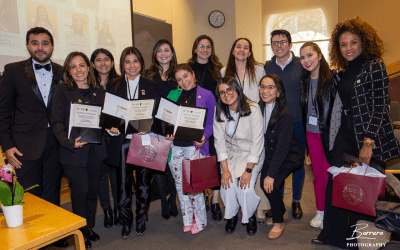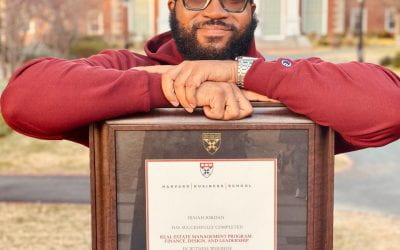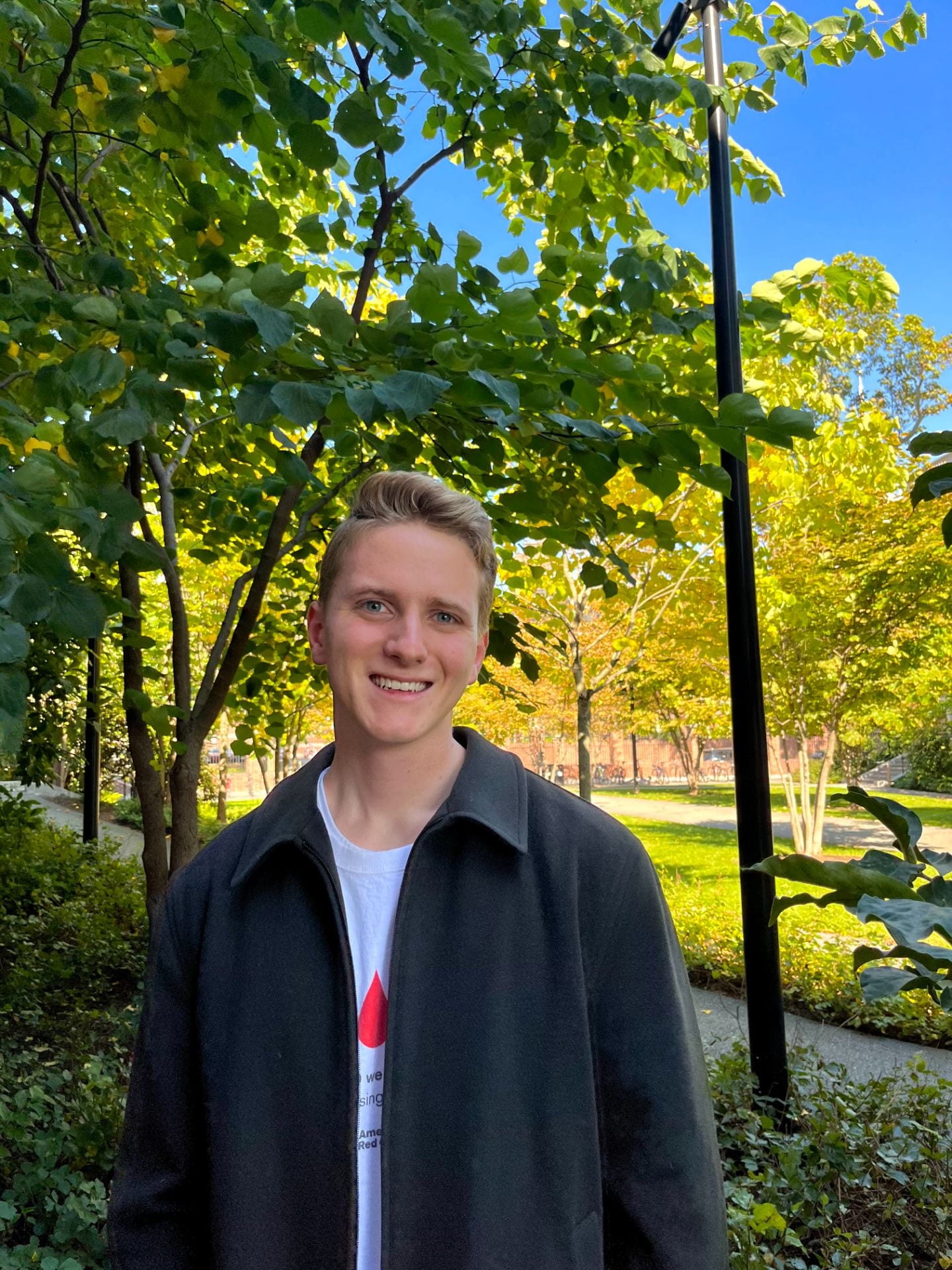
About the Author
Tyler Nilson is a Harvard college sophomore studying Human Developmental and Regenerative Biology and History of Science. He learned Spanish during a two-year religious mission for the Church of Jesus Christ of Latter-day Saints in Buenos Aires, Argentina.
Weapons of Mass Construction
Building a Puerto Rico for the People
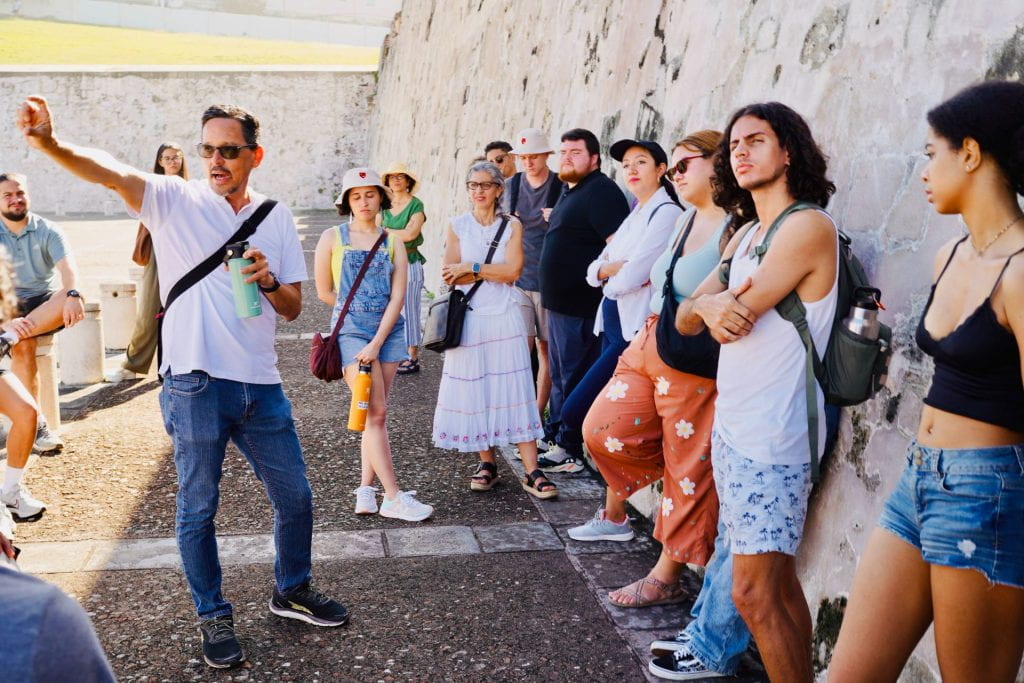
Professor of Architecture, Jorge Lizardi, guides students in a tour of Viejo San Juan
I zip up my raincoat and turn on my headlamp as we tread along a damp trail in El Yunque National Rainforest, Puerto Rico. There is a strange chirping noise in the trees: “co-kee! co-kee!” I open a bird identification app on my phone in an effort to detect the sound, but I get no results. Noticing this, another student approaches and explains, “Those aren’t birds, they’re frogs!” Before long, our wilderness guide emerges from the thick vegetation with a net full of chirping frogs for us to inspect.
This was my first night in Puerto Rico. As a participant in the Harvard Puerto Rico Winter Institute co-hosted by the University of Puerto Rico and the David Rockefeller Center for Latin American Studies (DRCLAS), I came to the island to explore issues of food sovereignty, sustainability and health. To my pleasant surprise, this investigation brought us out of the classroom and into the field. Day after day, we visited local markets, fisheries, museums, farms, restaurants, and—of course—El Yunque. Each visit uncovered another angle of this complex cultural climate. Like the birds who turned out to be frogs, our findings often subverted my expectations.
Our field visits were complemented by academic seminars, in which professors from Puerto Rico and Cambridge led nuanced discussions on property law, economic policies, popular religion, Caribbean eco-poetry, culinary history and globalization. I was intrigued by the cultural and political structures which govern the island and its people. Many of the places we visited showed signs of capital and colonial exploitation, yet the people with whom we conversed demonstrated resilience and vision.
Throughout the two-week program, the following questions were at the forefront of my mind. For whom is Puerto Rico designed? And how are local activists working to build a people-centered future?

Law Professor Érika Fontánez Torres gives a presentation on property rights and common resources
Baño de Oro and Baño Grande
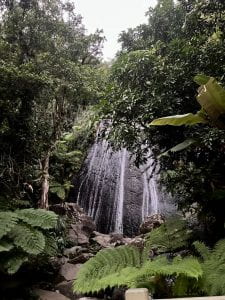
A waterfall in El Yunque National Forest
During the 1930’s, the U.S. Civilian Conservation Corps began several forest restoration projects. In El Yunque, federally employed workers paved hundreds of miles of roads and built towers, cabins, restaurants, picnic spaces and a trout hatchery. Our guide told us these pools were once popular recreation sites, frequented by military personnel and local politicians. However, as new roads opened the once secluded sites to popular access, the pools were allegedly closed in the name of public safety.
When we arrived at the abandoned pools, it was saddening to see the extent of their disrepair. The pools were filled with dark, silty water and covered in vegetation. The buildings were left open to the elements, now home to birds and insects. I was left wondering. These facilities were built with public funds by public employees. It seemed bizarre that once the roads were paved and the general public could reach the pools, they were closed. For whom, then, were they built?
Centro Comunitario Parcelas Suárez
Days later, our caravan arrived in Loíza, a coastal community famous for its Afro-Latino cultural influence. Community leader Modesta Irizarry led us to important ecological and artistic sites in the town. Starting and ending our tour at the mouths of the two rivers which fork the area, she compared the waterways to the arms of the town, giving us a massive hug. Along the way, we witnessed how coastal erosion has threatened the neighborhood of Suárez, where Hurricane Maria flooded homes in 2017.
Along the beach in Suárez, we find an arc-shaped building with zig-zagged ceilings. This is—or was—the Community Center of Parcelas Suárez. Painted pink and gray, the building bears resemblance to a clam. What was once a pearl of the neighborhood is now a hollowed-out shell. The hurricane’s winds and waves collapsed the walls and destroyed the facility. This story is not in isolation, as Hurricane Maria’s calamitous force damaged many buildings across the island. However, what makes this scene unusual is what lies in the foreground.
Parallel to the community center is an imposing wall of rocks: a seawall built to protect the beach from erosion. Adjacent to the seawall, the community center seems quaint. Upon later investigation, I learned that the seawall was built after Hurricane Maria by the United States Army Corps of Engineers. The project received a budget of five million dollars, and was completed at a cost of 3.3 million dollars. While some welcome the seawall, others complain that it has exacerbated erosion at other nearby beaches. Six years since the hurricane, the juxtaposition of the expansive seawall and the dilapidated community center is striking. Millions were spent on the controversial seawall. I ask myself, how much would it have cost to repair the community center only dozens of feet away?

The recently constructed seawall parallel to a damaged community center
El Josco Bravo
The next week, we returned to the mountains. This time, we were touring El Josco Bravo in Toa Alta, an agroecological farm founded by grower and educator Ian Pagán. On an island where less than twenty percent of food is locally produced, Pagán is spearheading efforts to improve food sovereignty and sustainability. Making effective use of environmentally friendly methods such as contour farming, avoiding pesticides and capturing rainwater, El Josco Bravo has converted undeveloped forest into a fertile farm. The catch? The land is on lease.
As was the case with other farmers we met during the program, Pagán is on a long-term lease from the Puerto Rican Land Authority. This government body serves as a custodian for over 80,000 acres of public land, which it distributes to farms, energy production, and natural reserves. In a recent documentary, Pagán describes the struggles he faced when a hurricane imposed economic stress during his first year on the newly rented farm, and the Land Authority sought to evict him from the property. Despite the obstacles, El Josco Bravo has continued to expand, inspiring other producers to adopt agroecological techniques.
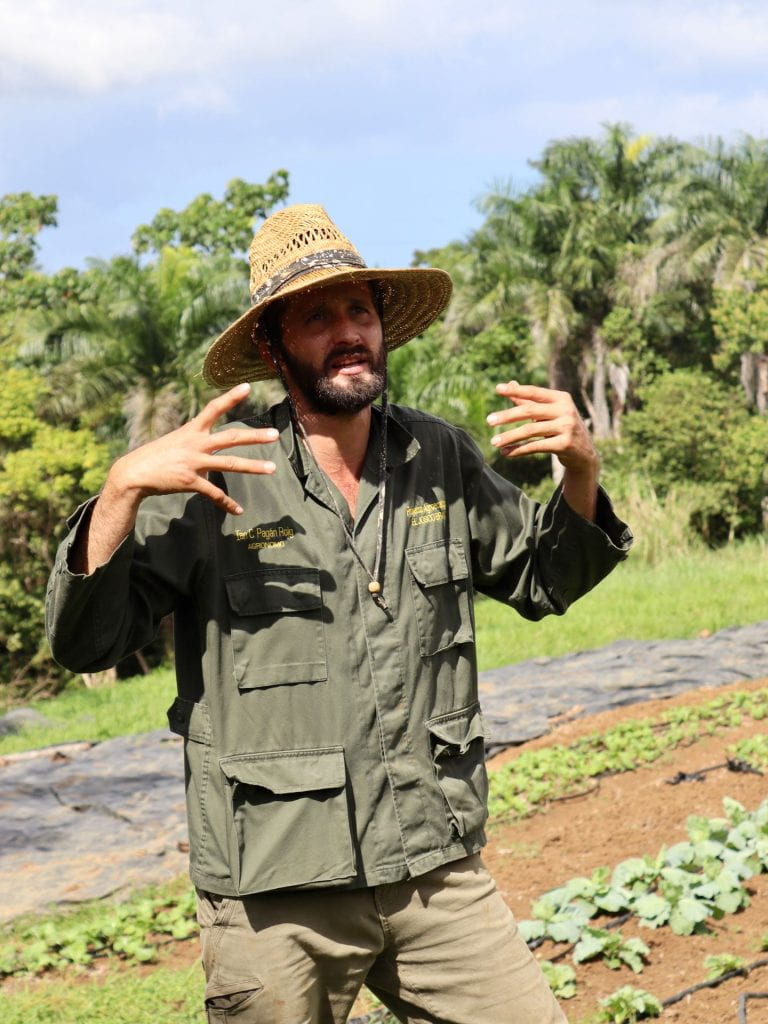
Farmer Ian Pagán lectures about food distribution systems at El Josco Bravo in Toa Alta
Complex Social and Political Landscapes
When visiting the market of Río Piedras, we stumbled upon a newly curated photography exhibition which claimed to portray the culture of Puerto Rico. Many of the photos depicted rolling waves, pristine beaches, nightlife, surfers, snorkelers and nude women. Several Puerto Rican students expressed their resentment towards this exhibit, describing it as an exoticized and disingenuous portrayal of their culture. I sympathized with their sentiments, feeling that the photographs neglected to capture the diverse local communities of Puerto Rico—instead catering to a tourist gaze.
Oftentimes, we drove by lavish country clubs and private neighborhoods. Legislation such as Act 22 and Act 60 has provided comfortable tax incentives to individuals and businesses who make Puerto Rico their home, creating a microcosm of wealthy transplants from the U.S. mainland seeking to protect their assets. While some investors are profiting from Puerto Rico’s generous tax policies, many locals are faced with rising cost of living and gentrification. As for local business, shipping legislation such as the 1920 Jones Act has resulted in increased importation costs and stymied trade opportunities. Furthermore, when Puerto Rico was burdened with over US$70 billion in debt and US$50 billion in unfunded pension liabilities in 2016, the United States Congress passed PROMESA, a law which placed the Puerto Rican debt under management of a Fiscal Control Board known colloquially as “La Junta.”
Despite these challenging circumstances, Puerto Rico continues to cultivate unique trends from music to cuisine to religion. For instance, innovative Puerto Rican music, dance, and food fuse Spanish, Caribbean, and African heritages. Notably, local reggaetón artists such as Bad Bunny have topped international charts. In another case of Puerto Rican tenacity, we met with local fishermen who expressed their love for the trade. Despite impediments from changing ocean temperatures, international competition and fickle regulatory policies, they persist. In response to these obstacles, some of these fishermen are encouraging local restaurants to offer more diverse fish dishes, contributing to culinary innovation. In a final example of Puerto Rican adaptability, many families have created their own unique traditions to honor the arrival of the Three Kings in January. On this holiday in which observers petition the Three Kings for blessings or favors, families express gratitude for answered prayers by opening their homes to the public in celebrations called “Promesas de Reyes.” Whereas celebrations of the Three Kings are common throughout Latin America and the Caribbean, these “promesas” are Puerto Rico’s own unique invention.
Pondering Puerto Rico
As I walk through the terminal at Luis Muñoz Marín International Airport on my last day in Puerto Rico, the voice of Dayanara Torres rings over the intercom: “Puerto Rico is my home and yours. It is diversity, it is culture, and it reflects the joy of our people. On behalf of our Luis Muñoz Marín Airport, I invite you to carry Puerto Rico in your heart.” The events of the last two weeks have left me with much to ponder. At the boarding gate, I put in my earbuds and hit shuffle on my playlist. A Woodie Guthrie song starts playing. As I listen to the lyrics, I sense an interesting parallel between this song and the scenes I witnessed in Puerto Rico.
At the same time the Civilian Conservation Corps was building Baño de Oro in El Yunque, Guthrie was bumming rides on railcars and penning some of the most iconic folk music of the U.S. West. His dust bowl ballads capture poor and working-class identities in an era dominated by mass displacement, crop failures, and economic distress. Guthrie’s most famous song, This Land is Your Land, has become ingrained in the United States musical canon as a patriotic anthem:
This land is your land, this land is my land
From California to the New York island,
From the redwood forest to the Gulf Stream waters;
This land was made for you and me.
The song’s melodic chorus celebrates natural landscapes and reflects a sense of national belonging, hence the tune is generally recognized as a celebration of American heritage. However, it’s likely that Guthrie intended to send a different message with his song. Guthrie was a vocal activist against government and corporate abuse, his lyrics sympathizing with migrant workers, criminals, farmers and the homeless. Interestingly, most renditions of the song omit these poignant verses at the end of Guthrie’s song:
As I went walking I saw a sign there,
And on the sign it said ‘No Trespassing.’
But on the other side it didn’t say nothing.
That side was made for you and me.
In the shadow of the steeple I saw my people,
By the relief office I seen my people;
As they stood there hungry, I stood there asking
Is this land made for you and me?
The plane lifted off, and the coast of Puerto Rico faded behind me. As I flew above Gulf Stream waters, the events of the last two weeks replayed in my mind. I felt the nighttime drizzle of El Yunque as I thought about Baño de Oro—closed to the people. I smelled the salty breeze as I remembered the 3.3-million-dollar seawall alongside Loíza’s tattered community center. I saw the brightly colored photographs at the exhibition, the brightly colored “For Rent” posters on Rio Piedras’ buildings, and the brightly colored marquees of San Juan’s luxury hotels.
Among it all, Guthrie’s question rang in my mind.
In his battle against injustice, Woody Guthrie toted an acoustic guitar painted with the words, “THIS MACHINE KILLS FASCISTS.” At El Josco Bravo, a poster of gardening tools brandishes the words: “WEAPONS OF MASS CONSTRUCTION.” The fight for Puerto Rico’s future has many fronts. Across the island, proactive citizens wield fishing rods, garden hoes, keyboards and paint brushes in defense of their land and their culture.
At the Puerto Rico Winter Institute, I met individuals committed to creating a Puerto Rico that prioritizes its people. I feel a deep sense of respect and gratitude for these people, who brought me into their communities and shared their hopes for a future written by and for los Boricuas.
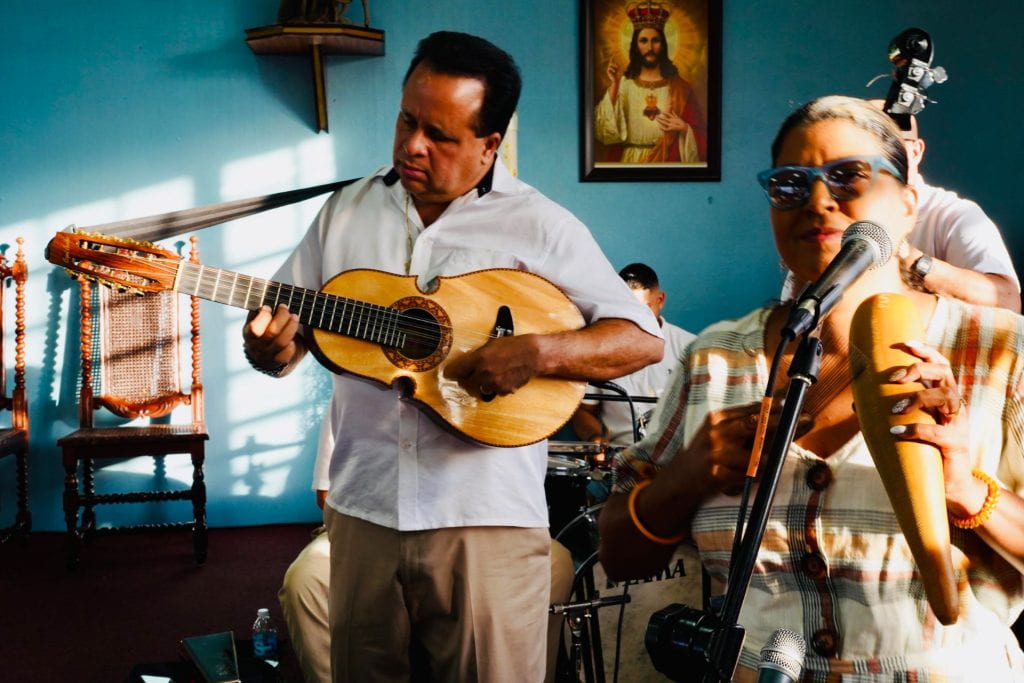
Members of the church band perform at a celebration of La Promesa de los Reyes at Capilla San Francisco de Asís in Carolina
More Student Views
Colombian Women Who Empower Dreams
English + Español
The verraquera of Colombian women knows no bounds. This was the message left with me by the March 30 symposium, “Empowering Dreams: 1st symposium in honor to Colombian women at Harvard.”
A Review of Born in Blood and Fire
The fourth edition of Born in Blood and Fire is a concise yet comprehensive account of the intriguing history of Latin America and will be followed this year by a fifth edition.
Resilience of the Human Spirit: Seizing Every Moment
In the heart of Chicago, where I grew up, amidst the towering shadows of adversity, the lingering shadows of generational demons and the aroma of temptation, the key to the gateway of resilience and determination was inherited. The streets of my childhood neighborhood became, for many, prisons of poverty, plundering, crime and poor opportunity.

